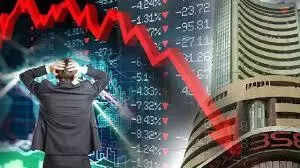Is India’s Stock Market Shaking? Decoding the Recent Sensex Slide
The air crackled with unease as the Sensex took a nosedive recently, plummeting a hefty 849 points. Investors, seasoned and novice alike, felt a ripple of anxiety. Was this a blip, a momentary stumble on the path to growth, or a sign of deeper tremors beneath the surface of India’s financial landscape? Let’s dissect what fueled this market movement and explore what it might mean for the future.
The immediate trigger? The spectre of potential tariff hikes. Talk of increased import duties, intended to bolster domestic manufacturing and reduce reliance on foreign goods, sent shivers down the spines of market participants. The worry stems from the potential impact on corporate earnings. Companies that rely heavily on imported components or raw materials could see their costs rise, squeezing profit margins and ultimately impacting shareholder value.
Adding fuel to the fire were concerns about election outcomes. As India navigates its democratic process, uncertainty inevitably creeps into the market. Investors often prefer stability and predictability, and the possibility of policy shifts following an election can trigger cautious behaviour, leading to sell-offs and market volatility. This isn’t necessarily a reflection of any particular political leaning, but rather a general unease about the unknown.
Furthermore, the global economic climate plays a significant role. Rising inflation in the US, coupled with hints of further interest rate hikes by the Federal Reserve, cast a long shadow. Higher interest rates in the US can make dollar-denominated assets more attractive, potentially drawing foreign investment away from emerging markets like India. This, in turn, can put downward pressure on the rupee and the stock market.

Beyond these immediate catalysts, several underlying factors contribute to the market’s sensitivity. High valuations, built up over a period of strong growth, leave less room for error. When the market is priced for perfection, any hint of disappointment can trigger a correction. Moreover, the increasing participation of retail investors, while generally positive for market depth, can also amplify volatility. Retail investors, often less experienced than institutional players, may be more prone to panic selling during periods of market stress.
So, what’s the takeaway from this recent market wobble? Is it time to run for the hills, or is this a buying opportunity in disguise? The answer, as always, is nuanced. It’s crucial to avoid knee-jerk reactions and instead focus on a long-term perspective. Market corrections are a normal part of the economic cycle, and attempting to time the market perfectly is often a losing game.
Instead, consider revisiting your investment strategy, ensuring it aligns with your risk tolerance and financial goals. Diversification remains a key principle: spreading your investments across different asset classes can help cushion the impact of market volatility. Furthermore, it’s worth remembering that India’s long-term growth story remains compelling. The country’s demographic dividend, burgeoning middle class, and ongoing reforms offer a solid foundation for future economic expansion. This recent tariff trauma might be a passing storm.
Consider exploring different investment options. Our guide to understanding mutual funds can provide valuable insights.
Ultimately, navigating market volatility requires a cool head and a long-term outlook. While the recent Sensex slide may have caused some anxiety, it’s essential to remember that market fluctuations are a natural part of the investment journey. By understanding the underlying factors driving these movements and staying true to a well-defined investment strategy, investors can weather the storm and position themselves for long-term success.







